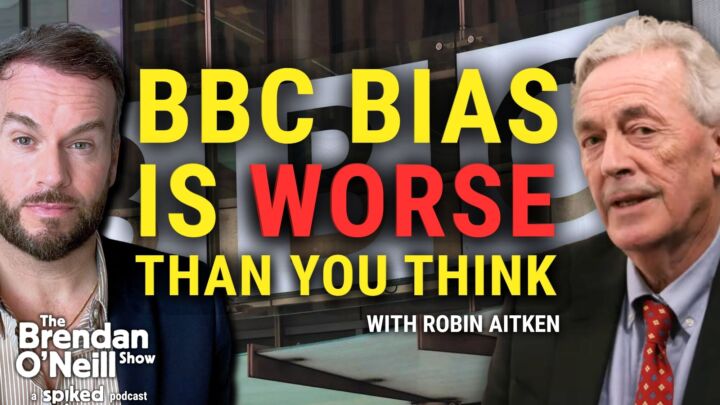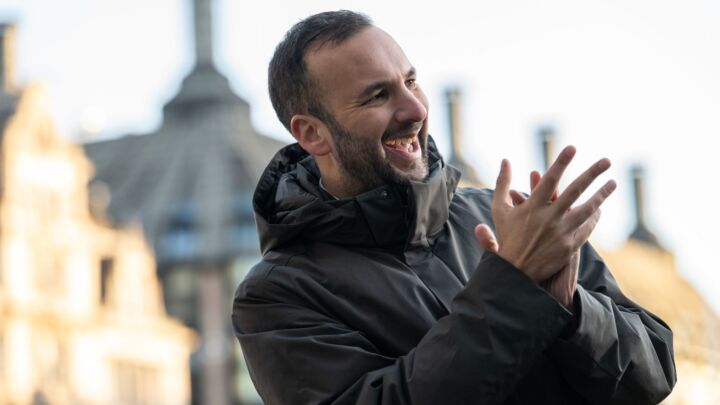Saving normal in a world gone mad
One psychiatrist’s rebellion against the pathologisation of everyday life.

Want unlimited, ad-free access? Become a spiked supporter.
In the early 1990s, American psychiatrist Allen Frances was chair of the taskforce that created the American Psychiatric Association’s Diagnostic and Statistical Manual-IV (DSM-IV) (published in 1994). The DSM is the book used by psychiatrists to track and describe mental disorders and conditions. He had previously been part of the team – led by a former teacher, Bob Spitzer – that created DSM-III (published in 1980) and DSM-IIIR (published in 1987). Now he is one of the most prominent critics of DSM-5 (published in 2013).
Frances describes his book Saving Normal: An Insider’s Revolt Against Out-of-Control Psychiatric Diagnosis, DSM-5, Big Pharma, and the Medicalization of Ordinary Life as ‘part mea culpa, part j’accuse, part cri de coeur’.
Frances’ arguments about the dangers of inflating psychiatric conditions and psychiatric diagnosis are persuasive – maybe more so because he honestly admits to his own role in developing such an inflation. He is keenly aware of the risks of diagnostic inflation ‘because of painful firsthand experience’, he writes. ‘Despite our efforts to tame excessive diagnostic exuberance, DSM-IV had since been misused to blow up the diagnostic bubble’. He is particularly concerned about the exponential increase in the diagnosis of psychiatric conditions in children, writing: ‘We failed to predict or prevent three new false epidemics of mental disorder in children – autism, attention deficit, and childhood bipolar disorder. And we did nothing to contain the rampant diagnostic inflation that was already expanding the boundary of psychiatry far beyond its competence.’
Take Attention Deficit Hyperactivity Disorder (ADHD), which is ‘spreading like wildfire’. This diagnosis is applied so promiscuously that ‘an amazing 10 per cent of kids now qualify’, Frances writes. In the US, boys born in December are 70 per cent more likely to be diagnosed with ADHD than boys born in January. The reason diagnosing ADHD is so problematic is that it essentially is a description of immaturity, including symptoms such as ‘lack of impulse control’, ‘hyperactivity’ or ‘inattention’. Boys born in December tend to be the youngest in their school year group (in the US) and thus they are more likely to be immature. In the UK, the youngest children in a school classroom are born in August, and so here, August-born kids are more likely to be diagnosed with ADHD. We have medicalised immaturity.
Until his colleagues started working on DSM-5, Frances had been ‘pretty much a dropout from psychiatry’ for almost a decade. But on hearing that DSM-5 was moving in ‘the wrong direction, adding new diagnoses that would turn everyday anxiety, eccentricity, forgetting and bad eating habits into mental disorders’, he felt compelled to get stuck in to the debate. ‘If a cautious and generally well-done DSM-IV had probably resulted in more harm than good, what were the likely negative effects of a carelessly done DSM-5?’, he wondered.
Until 1980, the DSMs were ‘deservedly obscure little books that no one much cared about or read’. DSM-I (published in 1952) and DSM-II (published in 1968) were ‘unread, unloved and unused’. Now, says Frances, this ‘bible’ of psychiatry ‘determines all sorts of important things that have an enormous impact on people’s lives – like who is considered well and who sick; what treatment is offered; who pays for it; who gets disability benefit; who is eligible for mental health, school vocational and other services; who gets to be hired for a job, can adopt a child, or pilot a plane, or qualifies for life insurance; whether a murderer is a criminal or mental patient; what should be the damages awarded in lawsuits; and much, much more’.
Today, as a result of various trends, including the impact of the DSMs, many human behaviours, quirks, eccentricities and woes which in the past would have been seen as parts of the rich tapestry of life are now branded mental disorders.
So, how did we end up in a situation where a manual for psychiatrists has gone so disastrously wrong, and had such a problematic influence?
Frances explains that in the postwar period the predominant model in psychiatry was psychoanalytic. The focus was on treatment, with an attitude of ‘can-do professional confidence’. This confidence was severely knocked by high-profile studies exposing the unreliability of psychiatric diagnosis. One of these was the Rosenhan experiment carried out in the early 1970s. Several of Rosenhan’s graduates went to emergency rooms in different parts of the US, claiming that they were hearing voices. Every ‘pseudo-patient’ was promptly admitted to a psychiatric hospital and kept for several weeks to several months, despite thereafter stating that they felt fine and no longer heard voices. ‘Psychiatrists looked like unreliable and antiquated quacks’, Frances writes. Before DSM-III (1980), psychiatry was a ‘pure art form’, according to Frances, ‘sometimes brilliant, usually idiosyncratic, and always chaotic’.
Bob Spitzer’s aim with DSM-III was to make psychiatric diagnosis systematic and reliable. Spitzer and his ‘young Turks of psychiatry’ were a ‘closely knit cohort of biologically oriented researchers who saw themselves as a vanguard pushing the field towards the rest of medicine and away from previously dominant psychoanalytic and social models’, Frances writes.
But the end result was a DSM that grouped patients based on surface similarities. This ‘simple-minded approach was absolutely necessary if psychiatrists were to agree on diagnoses – but it seemed to leave out almost everything that was interesting about the patient’, Frances writes. Understanding the patient had now been reduced to filling out a checklist of symptoms.
The worst consequence of DSM-III, however, was the ‘diagnostic inflation’ it encouraged, says Frances. Frances’ concern about DSM-5 (2013) is that we have now moved from diagnostic inflation to diagnostic hyperinflation. It is likely, he says, to trigger ‘a whole new batch of unfortunate fads on top of the ones we already have’. This is why Frances has set out to ‘save normal’.
He recognises the difficulty in saving normal, when, ultimately, it is impossible to come up with a clear definition of what is ‘normal’ and what is ‘abnormal’, or even what is a ‘mental disorder’. I agree with him that we should not go down the road of arguing that because a mental disorder is a construct it is therefore a myth. ‘Mental constructs of reality are imperfect, but indispensable, ways to organise the otherwise bewildering phenomena of the world’, he says. So, for instance, ‘schizophrenia is a useful construct – not myth, not disease. It is a description of a particular set of psychiatric problems, not an explanation of their cause.’
The reason Frances emphasises this point is because he wants to save both ‘normal’ and psychiatry. And he is absolutely right that both need saving. A society where ever-larger numbers of adults and children are defined by a ‘mental disorder’ is surely not a healthy one. Looking at the current discussions about addiction, he writes: ‘A vibrant society depends on having responsible citizens who feel in control of themselves and own up to the consequences of their actions – not an army of “behavioural addicts” who need therapy in order to learn to do the right thing.’
But saving normal is not the same as arguing that everyone is normal: ‘This shibboleth can be believed only by armchair theorists with no real experience in having, living with, or treating mental illness. However difficult to define, psychiatric disorder is an all-too-painful reality for those who suffer from it and for those who care about them.’
There is undoubtedly a need for a profession dedicated to helping those whose internal turmoil, and whose difficulties with living, are persistent and debilitating. But quite how psychiatry can be transformed from its current tick-box mentality into a profession able to help and care for those who are seriously struggling, I don’t know. The first step, surely, is to recognise that something needs to change – and Saving Normal illustrates this need very well.
Frances also rightly puts the case for why we need to look beyond the DSM to understand the hyperinflation of diagnostic categories. ‘Diagnostic inflation has many, many causes and will require many cures’, he writes. The psychiatric profession should take part of the blame – hence the mea culpa aspect of his book. But, as he writes, ‘Epidemics are driven by many powerful and converging forces: the drug companies’ aggressive selling of diagnoses; reckless thought-leaders; gullible patients and doctors; advocacy groups; the media; the internet; and social networking’.
Additional inflationary pressures come from the fact that many will be provided with benefits upon acquiring a mental-disorder diagnosis, and children and young people (and adults at university, for that matter) may be provided with extra services, more time on educational tests, and so on. So there is often a social or economic benefit to getting a psychiatric diagnosis.
Frances’ bête noire is the pharmaceutical industry. ‘The seeds of diagnostic inflation that had been planted by DSM-III would soon become giant beanstalks when nourished by drug-company marketing’, he writes.
But isn’t it inevitable that corporations will take advantage of a growing market? To my mind, the problem is primarily a political and cultural one. Opinion-formers – including politicians, policy wonks, the media, advocacy groups, NGOs and more – increasingly paint individuals as weak and vulnerable and incapable of dealing with challenging experiences and painful emotions without external help.
We are continually told that individuals will be ‘scarred for life’ by humiliating childhood taunts, regrettable sexual encounters or difficult emotions and experiences. My parents’ generation’s paraphrasing of Friedrich Nietzsche’s dictum that ‘what does not destroy me makes me stronger’ is today generally seen as callous and unsympathetic. But we don’t need to look too far back in history to recognise humans’ remarkable ability to maintain their humanity in the face of the most dehumanising experiences. If young people are repeatedly told how vulnerable they are in the face of painful experiences and emotions, is it any wonder that many internalise a sense of victimhood and powerlessness and therefore lose their capacity to cope?
Of course, people do not unquestioningly internalise the dominant cultural outlook. The human spirit is not easily destroyed. Yet Frances’ cri de coeur does seem daunting. Saving normal and saving psychiatry are mammoth tasks. For ‘normal’ to be saved, it is not going to be sufficient to change the wording of a manual. We need a cultural and political sea-change, too, a transformation in how human beings are understood and talked about today.
Frances finishes his book by asking: ‘Do we have a realistic chance to reverse diagnostic inflation or is the die already cast in favour of a neverending parade of false epidemics?’ His ‘rational self’ tells him that saving normal is a losing game. But never give up. ‘It remains reasonable to hold out some hope that common sense will prevail. People and policymakers may eventually wake up to the fact that we are not a bunch of sick individuals, each of us having a bunch of psychiatric diagnoses, cumulatively constituting a sick society.’ Hear hear.
Helene Guldberg is author of Reclaming Childhood: Freedom and Play in an Age of Fear and Just Another Ape?. Visit her website here.
Saving Normal: An Insider’s Revolt Against Out-of-Control Psychiatric Diagnosis, DSM-5, Big Pharma, and the Medicalization of Ordinary Life, by Allen Frances, is published by William Morrow. (Buy this book from Amazon(UK).)
Picture: Shutterstock
You’ve read 3 free articles this month.
Support spiked and get unlimited access.
Help us hit our 1% target
spiked is funded by readers like you. It’s your generosity that keeps us fearless and independent.
Only 0.1% of our regular readers currently support spiked. If just 1% gave, we could grow our team – and step up the fight for free speech and democracy right when it matters most.
Join today from £5/month (£50/year) and get unlimited, ad-free access, bonus content, exclusive events and more – all while helping to keep spiked saying the unsayable.
Monthly support makes the biggest difference. Thank you.










Comments
Want to join the conversation?
Only spiked supporters and patrons, who donate regularly to us, can comment on our articles.